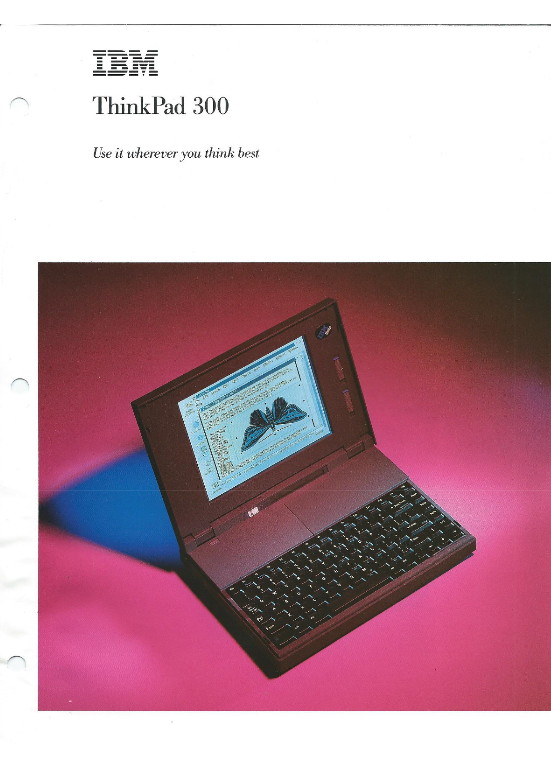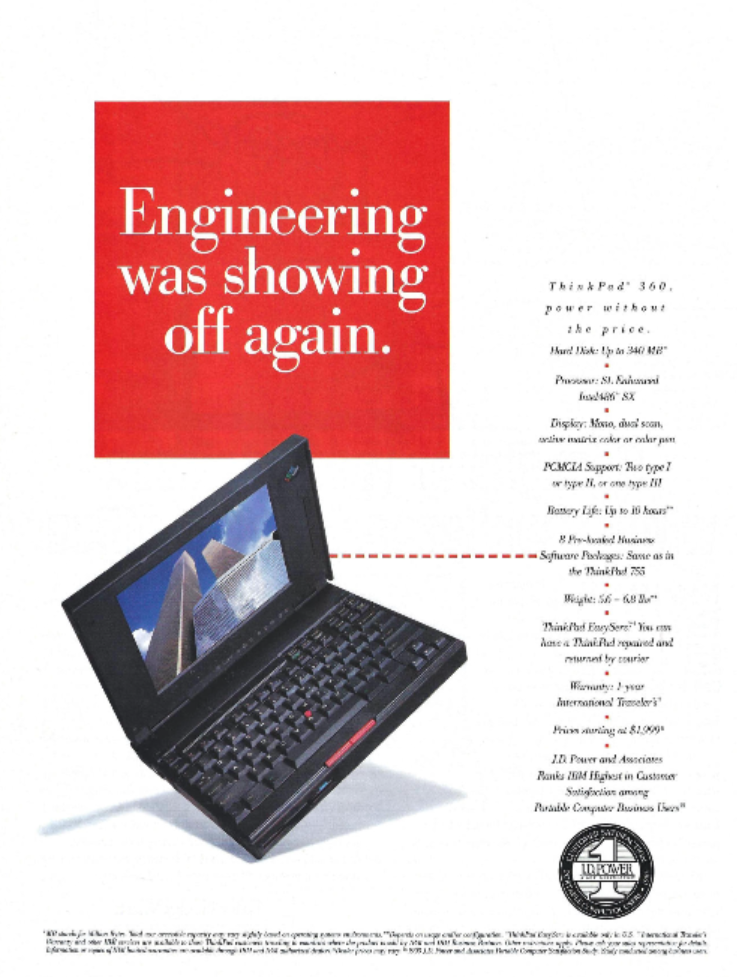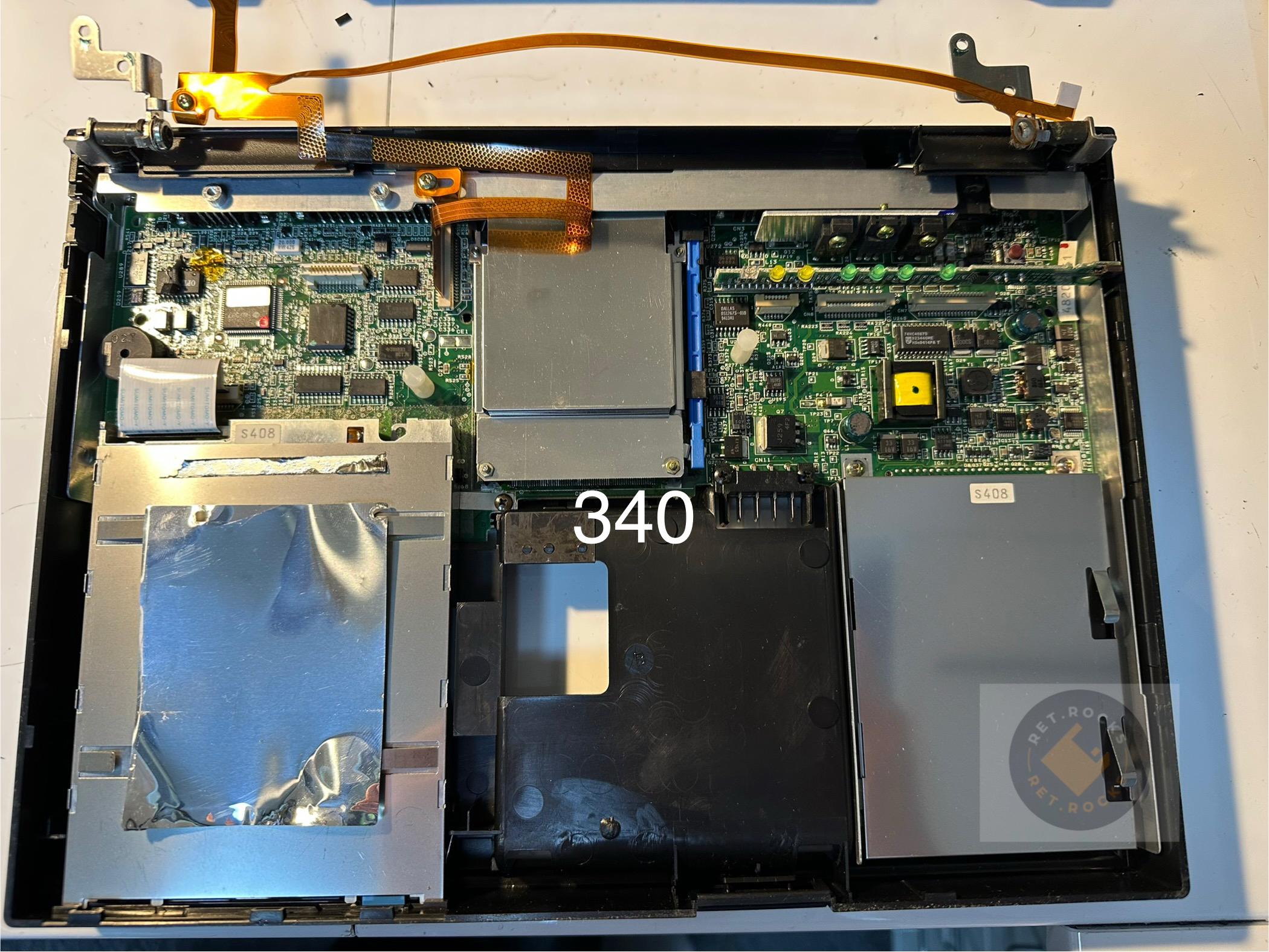Such a roller coaster of design, quality, manufacturer, timing. The budget portable IBM? The consumer portable IBM? The..... shittier portable IBM?
Many of them have suffered from being on the cutting edge of miniaturisation, economy and portability, whereas others have stood the test of time and still have a very useful place in today’s retro computing community. With the exception of the 320, all the pictures used in this article were taken by me for this article. None of the pictures are reproduced from anywhere else.
Foreword
My first point is to be aware that there had already been a two-tier portable strategy from IBM, which PS/notes became the cheap, consumer 'Value Systems" and Thinkpads as the higher end business portable. You'll find that there are some clues that most notes, or their descendants became members of the 300-series, as the lower specification (and lower cost) PS/note M23V became the Thinkpad 320 and the PS/note 425 became the 350, whereas the really high specification (and expensive) M52 became the Thinkpad 700.
The next point to know about the 300 series is that the chronological release of each model does not align with the 3xx numbering. The 300 was certainly the first (or was it? The 320 and 350 were essentially re-released notes) and the 390 was certainly the last but there is definitely some weird shit going down along the way. As a result, this article may look a bit strange because we will travel through time in a linear fashion by release date, covering them in the order in which they were released.
The idea of what the 300-series should be - low cost & consumer-focused remained the same throughout the decade in which they were made - perhaps with the exception of the 330 (which appears to have been a specific, low-cost machine for a specific audience, with no specific 330 'branding'). However there were three distinct design and manufacturing methods behind IBM's journey of the 300-series, which included outsourcing everything (twice), redeveloping other IBM portables or building ground-up in-house.
When IBM's rationale of giving every portable a three-digit number came to pass, IBM had already decided to focus all of it's internal (Yamato, Japan) resources on a 'premier' portable (C52) and send everything else to a 'third party'. This started with the initial Thinkpad 300 being a Zenith 'Value System' made by Zenith with little connection to the 700C Thinkpad released around the same time. This approach soon reverted back to home grown machines with their own design - the 350 and 320 being direct decendants of the PS/Note architecture from Japan (possibly with Zenith input), then back to the 360 and 370 which trace their roots directly back to the enterprise 750 and 755 Thinkpads including many transferable parts, and then finally back to having completely independant fresh IBM designs, distinct from any other Thinkpads (the 340, 365, 380 and 390) whilst throwing in the oddity that is the outsourced 'Acer' 310/315 in the middle of those machines.
300-series machines tend to pack less expensive contemporary silicon, modems instead of networking, plastics instead of metal or fancy rubber coatings, DSTN instead of TFT and cheaper keyboards. Despite all of this, many were far better machines than the competition. My first Thinkpad was a 365X was the same price point as a decent Toshiba or Compaq on the Tottenham Court Road. I had no allegiance with IBM - but the Thinkpad which I saw and tried sported a unique, sharp, bright and ghost-free TFT, a brilliant and unique built-in pointing device, Pentium processor and a built-in CD-ROM. And it was BLACK!
Here is a 300 series release timeline for your delectation:
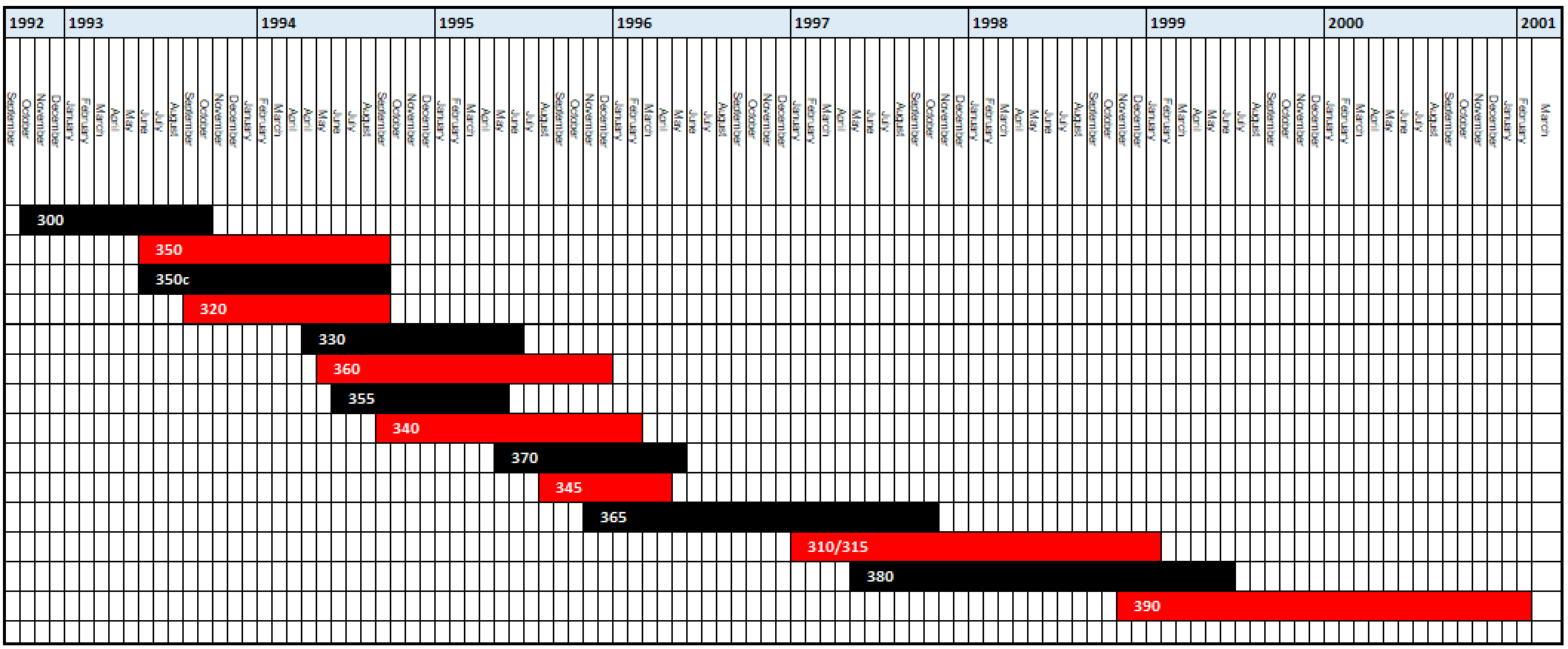
IBM Zenith Thinkpad 300 2615 – October 1992
The first and many would argue the worst! It was absolutely nothing like the incredible 700C released at the same time whilst both were branded as "Thinkpad". Could you imagine ordering what you thought was a TFT, trackpointed, aeroplane-friendly Thinkpad 700C and receiving this piece of plasticated dogshit? It was made by Zenith and had virtually none of the revolutionary features which made a 'Thinkpad'.
As previously mentioned, IBM had (briefly) decided to focus on the premier market 700-range and outsource the 'Value Systems' end to third parties. This is why the 300 is nothing like an IBM.
Released for $2375, it had no TFT - it didn't even have colour! It was an awful VGA monchrome passive screen. IBM had placed a bet that they could shift thousands of their brand-new, jointly manufactured TFT colour panel, but they never imagined the 700C being quite the box-shifter it became - so likely hedged their bets by allowing Zenith to use any old tat which it was throwing into it's own portables of the time so as to lower the price and not rob inventory from it's flagship portable for business.
It also had no pointing device whatsoever - and in particular, no trackpoint - no inventory or economic reasons for this decision, apart from my guess that IBM didn't realise what a class-leading feature, the red trackpoint II was. One of the key marketing features of the 700C Thinkpad was that you could use it in an economy-class seat, in the dark or sunshine and not have to elbow the people around you. With a crap screen, a wired trackball, side-popping floppy drive and a battery that lasted 90 minutes, you were unlikely to be the envy of your fellow passengers.
The painted grey plastic looked like something that had been made to carry eggs. Once. And on top of all this, it had a reputation for arriving DOA to it's new owner!
As of 2025, they're either dead, worn out, dying or simply forgotten.
My one has been repaired a number of times and still feels like it's clinging onto life by a thread. As you can see in the pics below, lined up against it's Zenith half-brother - the snappily-named Zenith Z-Note 433Lnc+, it clearly has the same hardware, with some subtle changes here and there. It's absolutely definitely *not* a Thinkpad.
Between the summers of 1992 and 1993, IBM was throwing a lot of shit at the wall. The 700C was blowing up and it was simultaneously trying to flog that horse as much as possible, not rob it's own customers with cheaper versions and gain as much traction in the lower end notebook market as possible. Add to this that the PS/note branding had garnered a worthwhile amount of traction, whilst IBM were shifting to a new numerical model range. So during this time frame, you had the outsourced Zenith PS/Note N45SL and Thinkpad 300 (virtually the same machine), you had IBM-developed PS/note 2141-182 which was it's own thing, along with the PS/note 425/Thinkpad 350 as home-grown Value Systems and you had the Japanese-evolved PS/note N23, N33 and C23V machines. It's a shame really that the outsourcing to Zenith took the 300 name alongside the 700C because a home-grown N33 decendant would have been much nicer.
Conclusion: Hideous, Crap, Not a Thinkpad. Probably DOA even more so than it was then. The worst!
IBM Thinkpad 350 2618 – June 1993
Now this is possibly stranger than subcontracting out to Zenith. What we have here is a re-hashed PS/Note 425 - a machine that had been left in the dust by the Thinkpad 700 with some unique design quirks and something which has also become a bit of a time bomb when it comes to the type of plastic used to form the chassis and the way they designed the hinges. Essentially, the plastic case is extremely brittle and is liable to crack - and the increasingly stifferning hinges put all of their force onto the case as the lid is opened and closed. As a result the chassis snaps apart into dozens of tiny pieces and the obvious 'swinging lid' form factor of almost every notebook computer ever concieved is lost. Reinforcing those plastic hinge-bases often feels like a practical solution but in my experience always ends up in a frustrating mess of even more plastic, epoxy, glue, plastic cement and still a broken lid. Even if the hinges aren't shot, then the capacitors will be leaking, the keyboard and LCD ribbon cables will be breaking and cracking and the display will be failing.
I guess at least it was actually built by IBM, but it seems they really hadn't worked out hinge design yet. At least not lasting hinge design. To be fair, the 700 and 720-series also suffer from a similar kind of deadly brittle plastics around un-reinforced hinges, meaning they tend to suffer the same fate. But it's easier to love a 700. It was soon after June 1993 where IBM began to.....crack it - or more to the point, work out how to improve the design of hinges, learnt more about where the forces could be directed, improved their foundations and in better plastics, how to stop it all cracking.
This makes the 350 a very difficult machine to love. I feel torn because on one hand, it does reflect some of the design lineage between the pre-Thinkpad PS/Note machines and the 'proper' 700 Thinkpad - even if only for the fact it has a PS/Note design and a Thinkpad red trackpoint. On the other hand, it's still got a bloody awful colour passive/DSTN display.
It's the only Thinkpad machine to actually mention it's model designation on the IBM badges as well as being the only 300-Series thinkpad to advertise it's processor with markings on the case. Somewhat reminds me of when cars had increasingly stand-out chrome model designations on the boot lid. XR3i anyone?
Japanese notes had developed a trend to put the model number in the IBM 'racetrack' emblem and seeing as this machine is an obvious step-brother to the note 425, that style of branding briefly carried through to a Thinkpad, and for a brief period IBM liked to put the processor front-end centre on a machine's branding.
I took my (and it's) life in my hands taking these pictures. I could tell that the lid was going to destroy everything it's connected to, at any moment.
Conclusion: The second and the second worst 300-Series Thinkpad. Really a relic of the PS/Note days where really we had all moved on. You wouldn't have wanted one then and you certainly don't want one now.
IBM Thinkpad 320 5523 – Sept 1993
Impossible really to give a view on because I've never seen one for sale or barely even mentioned. There is a single A4 press/marketing sheet showing what looks like a PS/note M23V (a later PS/note 5523 model), badged as a 320 and with the same model designation as the later Asia-only 330-Series. Apparently it was only ever sold in Japan at a time they were transitioning the Value Systems range away from the Fujisawa (in house) PS/55 Note series to the outsourced Zenith 300.
"Essentially the ThinkPad 320 is an updated PS/55 Note M23V, retaining the basic chassis, keyboard and VGA mono screen, but upgraded from a 386sx 25MHz CPU to a 486slc 25MHz CPU."
I suspect IBM excluded the C23V's 10.4" TFT screen in order to keep the 700C the only 'Premium' TFT notebook. What also gives away it's note credentials is the missing trackpoint and 5523/8533 case design. Which would make sense, if only the picture below wasn't of a color machine. Maybe they just stopped selling it altogether to ensure the 700C was king.
The evidence points at this being just another stillborn dead-end model that couldn't justify it's continued existence. The 300 was outsourced, monochrome and cheap and the 700C was in-house and expensive. IBM suddenly 'didn't do' in-house cheap unless customer's short-term demanded 'another note'.
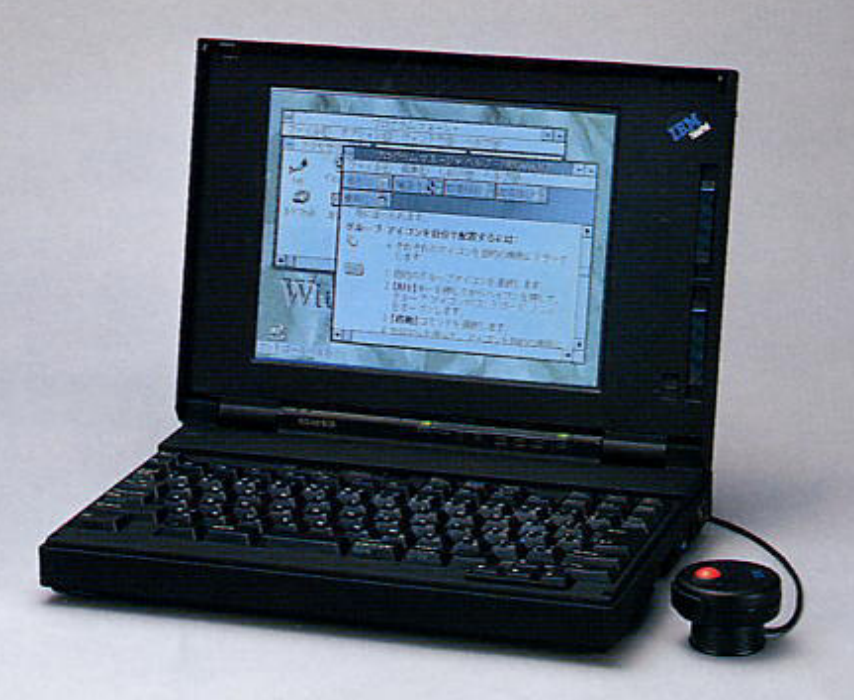
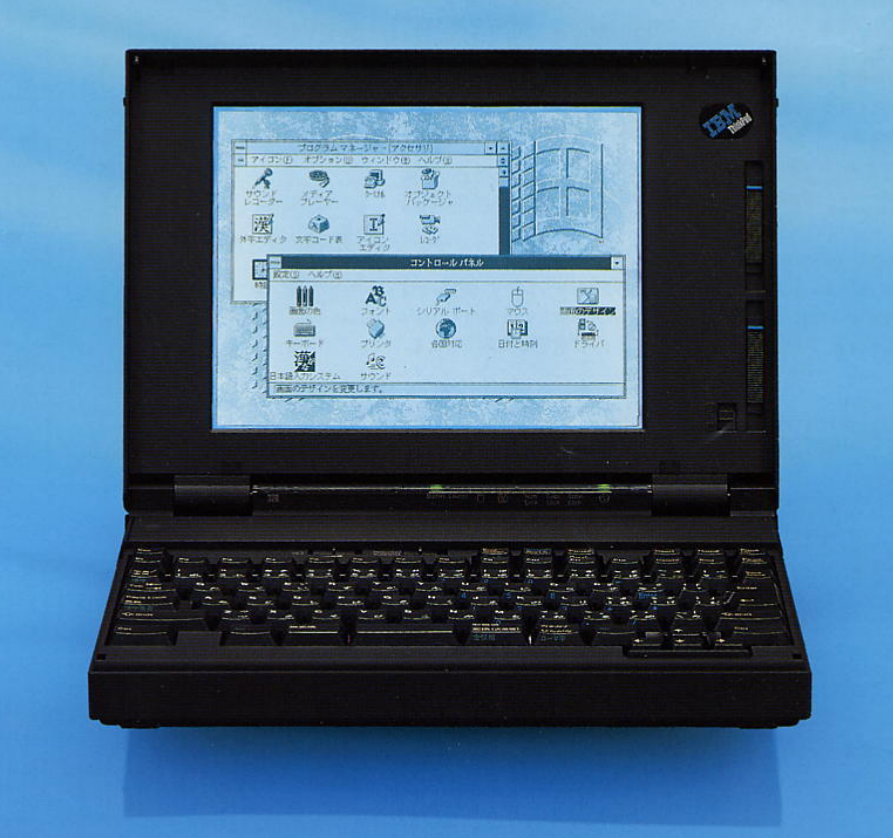
Conclusion: A mystery! But by the looks of it, it was a 300-Series Thinkpad and could have well been the 300 we never got.
IBM Thinkpad 330 5523 – April 1994
This machine came from the dying embers of the 5523 PS/ note family of Japanese "Value System" notebooks which started with the original Japanese PS/55 note, evolving into the 16Mhz PS/55 N23 SX and subsequent international releases with a Western keyboard and Kanji-delete N33 machines. As IBM decided to focus on it's Premium Thinkpads and outsourced their "Value" notebook designs from Zenith, it seems some small division of IBM mobility in Japan lived on making the C23V (a colour N23) which was renamed the Thinkpad 320 and finally this 330. All of these machines were in the 5523 model type range (even the 8533 Westernised notes were just 5523 machines with a different 'type') which remained ISA throughout IBM's journey through MCA. My guess is that due to the general (local) success of the PS/55 notes in Japan, many did not like the replacement offerings from Zenith and IBM would foresee some continued sales by keeping some evolution of the 5523 notes going.
What makes the 330 unique in late 1993 and 1994 is:
1) It's grey. Until this point only the occasional Acer iSeries and Germany DIN-Grey 700, 720 and 750 Thinkpads had been grey.
2) The trackpoint was firmly established as necessary and #Thinkpad by 1993 and yet it doesn't have one,
3) Whilst it has a battery compartment, all 330 machines did not come with a battery, and instead a built-in power supply (along with a seperate external power supply connector)
4) It does not have the 330 model number anywhere on the machine - only in marketing material.
The case design along with it's keyboard and lack of trackpoint is firmly from the PS/ note architecture, but overall, these design choices point towards some special order somewhere along the line. It's almost as if, a large buyer invited IBM to submit a RFP for a low-end desktop replacement at the lowest cost possible. This would explain why it didn't have a battery, trackpoint, is largely found with a mono or DSTN display, rather than the TFT option and has the same keyboard as most 'Value Systems' notes. Press materials also suggest it was also released on general sale.
It could also be speculated that IBM wanted to steer customers of the 5523 range into a dead end by making the final release a battery-less 'desktop explacement' in order to make it a simple choice for customers to look at other IBM mobile systems.
It's the only thinkpad with a weird, detachable and often-missing foot on the base.
And here is a quick side-by-side comparison of the 330 alongside the original PS/note
Conclusion: More of a relic from the note "me too" era, than a 'proper' Thinkpad. It's not black, it doesn't have a trackpoint or a battery. Still, an interesting conversation piece.
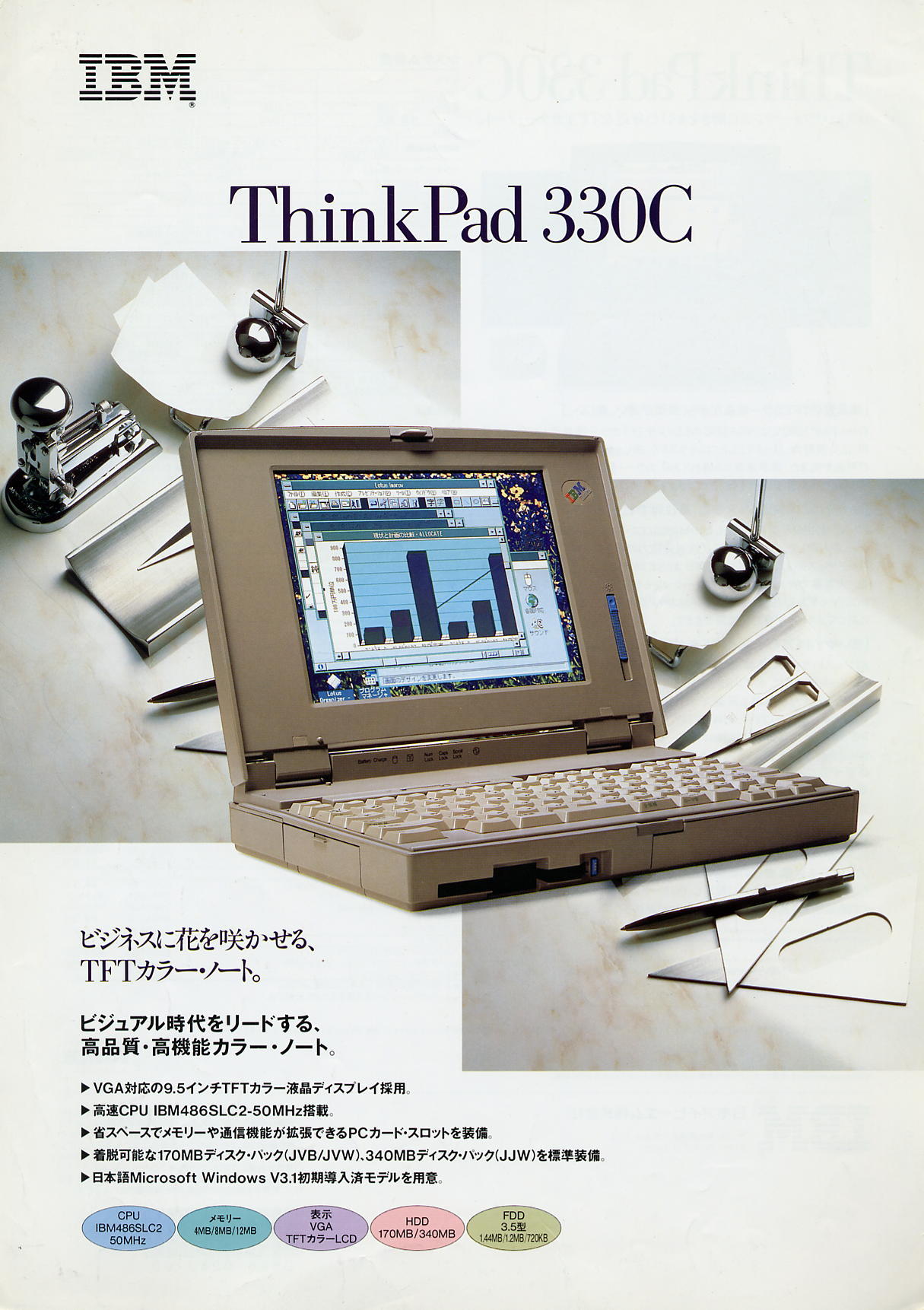
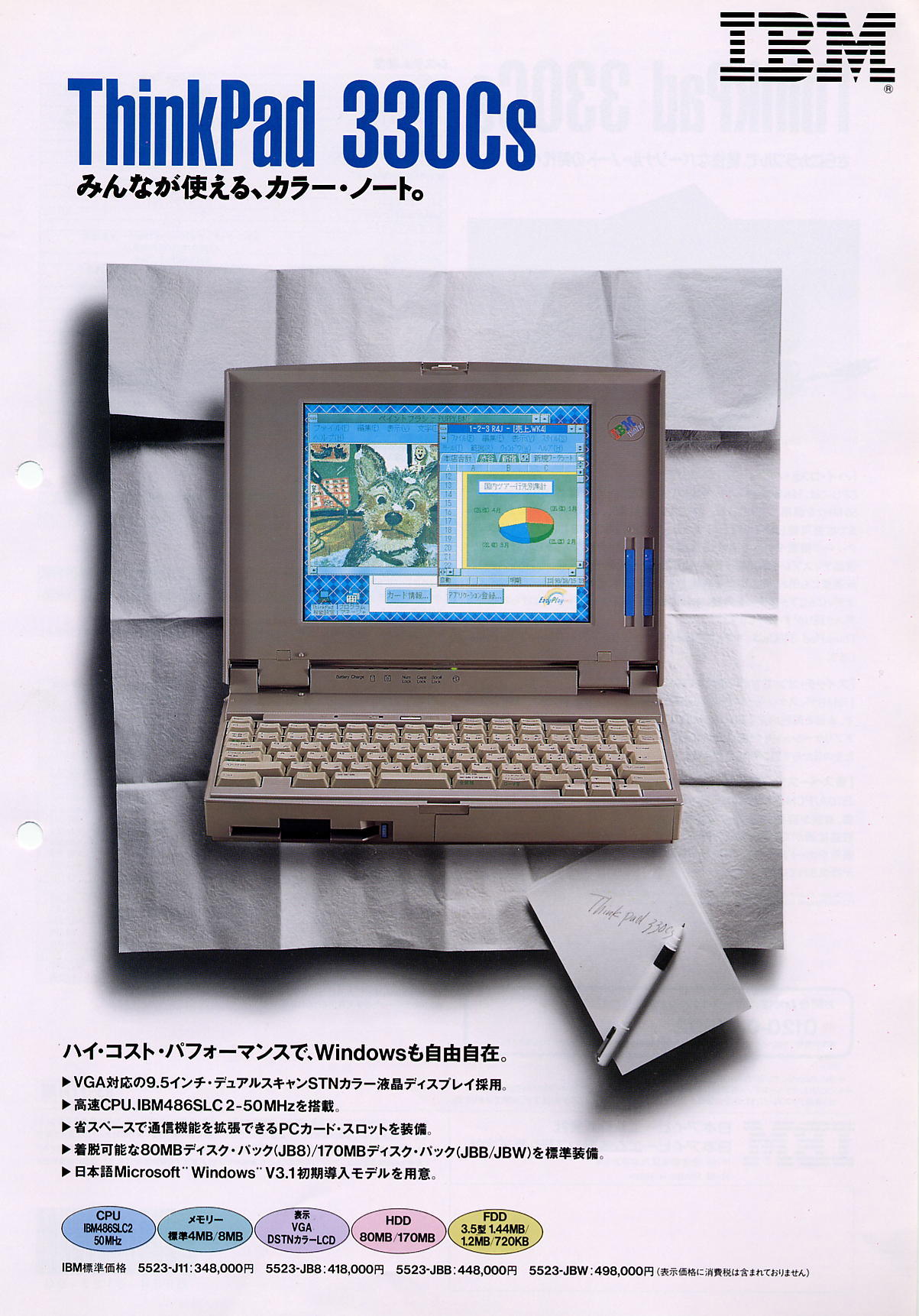
IBM Thinkpad 330C & 330Cs Marketing
IBM Thinkpad 360 2620 – May 1994
Right. Now, Here we go. We are cooking with gas now. IBM finally realised it was worth doing Value in-house. It's kinda like a cost-reduced (and I believe practically 'paired' with) the enterprise Thinkpad 750 - albeit with cheaper feeling plastic case, smaller TFT panels (as a high specification version), but finally a machine that IS a Thinkpad. It's black! It's got a red nipple! It's got a TFT (as an option). It has a lift-up keyboard for internal access. . . Its nothing to be ashamed of. The keyboard hinges up like a 750 to expose lots of it's guts. Lovely stuff. You could swap out the HDD and the floppy whilst waiting for your orange juice and prezels. The battery is still awful, but at least it would have worked for the first 10 years.
You could argue the 360 makes more sense in 2025 than a 750 because it wasn't coated in weird chemical rubber concoctions that generally look scatched to pieces of are gradually rotting, covered in dog hair and dropping off like zombie flesh. Most of the 360 machines I have encountered look fairly 'new'!
What makes the 360 even more special is that is had some rather special variations - namely the 360P and *slightly upgraded* PE models, which had a lid which could be folded completely over itself and then you could close the machine back up it just a screen and a stylus for touch-sensitive wow-factor. IBM sponsored the 1994 Olympic games and forced thousands of these embryonic tablets onto the workforce. I wonder how many people hated this form factor by the end? It's a shame they continued to cheap-out on the displays because the DSTN-ness of this tablet really is a bit of a ball-ache.
Little bit of nerdy trivia. The 360 shares the same battery type as the business-end IBM Thinkpad 750-series, but without it's super-doopa intelligent charging system. So if you have a 750 with a dead battery, that refuses to take a charge, you can pop it in a 360 and it may well slowly bring it back to life.
Conclusion: Innovative (for the consumer, at least) and finally a proper thinkpad! Nice to user then, nice to use now.
IBM Thinkpad 355 2619 – June 1994
The 355 is really quite strange. Usually any 3x5 model is either a later revision of it's 3x0 model or a special revision aimed at a specific market. For example, the 345 is almost exactly the same as a 340 and a 315 is almost exactly the same as a 310. The 385 model range was almost exactly the same as the 380 model range but I believe it was aimed at the educational market.
However in the case of the 355, it's is absolutely nothing to do with the hideous 350 and we should all be eternally grateful for that. It's actually almost exactly the same as the 360. I don't quite know why this even exists. However, as it has all the same niceties as the 360, but, even more curiously was released the following month. I sniff a special order. Schools?
Conclusion: I don't understand why this exists, but anything that shares it's heritage with a 360 is OK by me!
IBM Thinkpad 340 2610 – Sept 1994
Ok, another curve ball. They seemed to get the design right with the 360, but then four months later, IBM manufactured and released the 340. Why is it completely different, practically as good, released later, but with a lower number? I say completely different - but it is definitely a thinkpad. It's black, it has a trackpoint, nice keyboard, accessible on an aeroplane and nothing to be ashamed of.- but looks and feels like it was made by a different division within IBM altogether starting with an ideally blank sheet. It's like an IBM executive decided to play two different design and manufacturing hubs off one another, and the losers get fired. I really like the monochrome 340 and I don't know why. They age really well. Nothing seems to go wrong (besides the power jack has a habit of being unresponsive - perhaps corrosion?) and they often look and feel like the day they came out of the factory.
It's a shame the keyboard doesn't lift up - and the outside does look distinctly cost-reduced compared to the 360. No hinged keyboard, fewer connectors, weird bulky barrel-jack power connector and a less satisfying push on/off button above the keyboard (rather than the 360's push-switch on the side).
Inside the 340 looks distinctly different and hugely simplified over the 360. You get the feeling that IBM started this machine from the ground up as a far cheaper alternative to re-using the 750's modular design which would accomodate all sorts of different boards (which was carried over to the 755).
Conclusion: Possibly the most 300-Series that exists. It's completely NOT a 700-Series derivitive. It completely IS a Thinkpad with a nice case, screen, keyboard, trackpoint, battery, designed and built by IBM and...it's black! It's certainly designed from the ground-up as a consumer model. If this had been released instead of the 300 or the 350, then it truly would have been earth-shattering.
IBM Thinkpad 370 9545 – May 1995
Here we go. Almost peak 'original, thinking-man's, consumer's 7xx-series' 3xx Thinkpad. It's basically a 755 in a more plasticky shell. Well, there are some other differences but I guess as the 700 series was evolving into the swishier 760 and 770 with much bigger screens and flashy keyboards, the 3xx Series was briefly a kind-of 'last year's 7xx range.
Conclusion: A really nice alternative to a 755, due the case weathering better over the last 30 years. Modular, repairable, swappable, nice screens, nice keyboard.... Nice!
IBM Thinkpad 345 2610 – Aug 1995
It's a 340 but slightly better. I don't know why, but it feels less sturdy, less well made and all a bit shinier plastic. Was it a cost-reduced, cost-reduced 340 Thinkpad?
Conclusion: Just a 340 but slightly different.
IBM Thinkpad 365 2625 – November 1995
365 is another shocker. It's not a 'slightly newer' 360. It's definitely it's own machine. It had TFT. It had a Trackpoint. It had a CDROM! It was my first Thinkpad, so maybe I'm biased. In the 1990s I made a lot of friends (including sexy ones), I played GTA for the first time, I printed, I scanned, I listened to music, I reinstalled Windows 95 and 98 lots of times and I dicked around on all sorts of this thing called the 'internet'.
I did used to wonder why, under the keyboard was this strange plasticky-papery cover over all the bits. I think IBM were letting the consumers out their feel like engineers by swapping a hard drive, without letting the short out a microchip with their toenail clipper. It's the only Thinkpad with both a protective layer and a marketing poster built-in.
Conclusion: I have to condede it's special to me, and it's an excellent contender. The insides really are starting to move on in their own unique space and design now.
IBM Acer Thinkpad 310/315 2600 – Jan 1997
Ok so this is almost a hanging offence. People should have died because of this abomination. It's totally crap. The keyboard is awful, plastics worse. Most of the screens were shit. Even the trackpoint feels like some crappy rip-off. You can smell a rat the instant you turn it on and there is no 'Easy Setup' - just some generic BIOS with a couple of options.
If you ever came across an Acernote Light 370PCX you may notice some similarities. The main one being is that they're both crap.
That's because this Thinkpad was built by Acer. I really don't know why. Maybe it was some kind of experiment (Acer also later concieved the weird and cool G40).
There are two plastic covers over the hinges which you have to remove to disassemble the thing and if you merely look at them in a slightly strong manner...they snap.
For my sins I have two restored machines pictured below - restored meaning bits like the explosive hiberantion battery have been removed - a 310 and a 310ED. Both have bloody awful DSTN screens and Windows 95. One has a built-in 3.5" floppy drive and the other a CD-ROM.
This machine is a really dark horse. On paper and in pictures, it looks great. Definitely a more modern design than the previous 3xx models, with a slightly sleeker case and keyboard. But try to use one and it's baaaaaaad.
And here is an Acernote Light 370PCX in all it's -very similar- glory...
Conclusion: Just a disaster. An almost-dead end in subcontracting out the blessed brand. You wouldn't want one to use and you don't want to have to repair one. Best left in a google image search.
IBM Thinkpad 380/385 2635 – May 1997
I'd say this is jointly peak 380. If the remit was to sell a wonderful consumer laptop machine, then this is it. Big screen, nice keyboard, expandable, (just) portable. No real weaknesses (aside from the ones with the dying technology that was DSTN screens, I guess). It's a tubby thing - with a very fat base. A bit weirdly flabby to be honest. However these machines just run and run and run. Very useful to have a later one with a USB port alongside PCMCIA, Windows 98, optical and floppy. You can convert, unpack, copy and decompose all sorts of shitty old software on this thing. The plastic is a bit cheap and nasty but it certainly has some kind of charm. A good, honest retro machine. It's has forgotten a few key elements of what makes a thinkpad great, but it's still great.
The 385 models are rarer to spot as the were sold to educational customers whereas the 380 models were sold to retail - which is why my 385XD has a rather unusual corporate name silkscreened onto the LCD's bezel.
The later 380 and 385 models had many improvements over the earlier models as well as tending to come with a TFT display over DTSN. In the picture below with the later model on the left, you can see how the hard drive has been moved to a user-maintainable door on the front-left of the machine, so you can do a quick swap without stripping the machine down. Note also the stereo speakers with subwoofer hidden behind the front of the machine which are absent on the older model on the right.
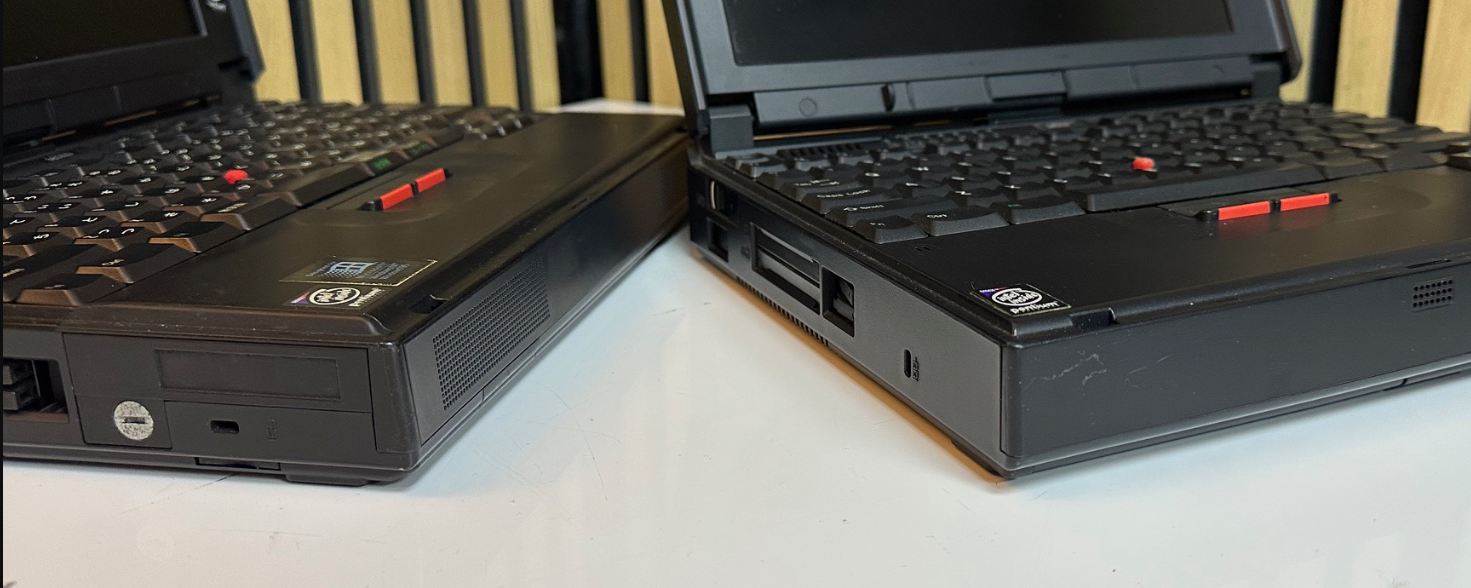
Conclusion: Not exactly beautfiul and certainly not premium but a real tankbuster over a piece of hardware and will probably outlive all of us.
IBM Thinkpad 390 2626 – Nov 1998
We're back to the hinges again, aren't we? Well at least on the early models. Have we reached the ultimate 3xx series? I guess as far as model range is concerned, this is the 300-Series machine with the biggest drives, the fastest processor, biggest RAM, largest screen.... It's got floppy AND optical drives built-in. It's god a weird proprietry IDE interface for the hard drive which conveniently slides out of a trap-door on the rear....an interface I've seen in a variety of laptops of this era - I wonder if it was close to a standard....
The cracking case appears to be most prevelant on the earlier releases - there seem to far fewer signs of weakness in the later 390E and X models. Perhaps IBM re-worked the plastic formula?
It was only recently when I realised that the largest 15" screen in the final 390X iteration meant a completely different chassis to all the other 390 machines - including the 14.1" models. The speaker was moved from the LCD bezel into the base, the entire machine is a larger, more imposing beast, which paved the way for what would partially become the A20. They're visually strikingly similar.
As far as a legacy machine - it's quite a nice option. It'll happily run a few different old Microsoft operating systems. It has USB alongside PCMCIA, floppy, optical, parallel serial and a few other bits and bobs. It certainly has a certain amount of 'consumer' feel to it. The speaker design is rather pleasant.
It's a machine that's easy to like for it's practical use, but not an easy machine to love. Perhaps the Vauxhall Cavalier of the 3xx Thinkpads?
And as a little bonus - here is a comparison of the 14" 390X with the larger 15" 390X with it's repositioned stereo speakers:
Conclusion: A nice machine, where you're starting to see a new formula of 'desktop replacement' that appeared in the G and A series machines. No longer really strictly in a consumer space, or a business space. Just a productivity tool that is still built like a tank - just not as expensive.
